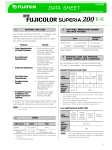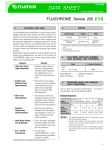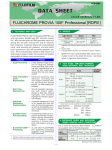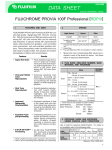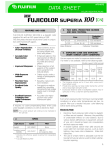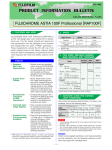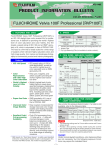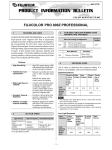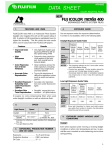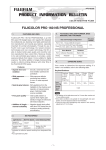Download Fujifilm Sensia 100 135/36
Transcript
AF3-091E COLOR REVERSAL FILMS FUJICHROME Sensia 100 [RA] 1. FEATURES AND USES FUJICHROME Sensia 100 [RA] is an ISO 100 high-image-quality daylight color reversal film. Features of this film include beautiful skin tones, natural and true-to-life color reproduction, and smooth textural depiction. Its high color-temperature tolerance during exposure makes it easily and widely applicable for slide production not only for snapshots, scenery, and other general photography, but also for medicine-, science-, and industry-related photography. Sensia 100 is ideally suitable for slide projection and for making big enlargements, as well as for printing on FUJICHROME paper and making high-quality duplicates using duplicating film. Features SPEEDS Light Source Speed Filter Daylight ISO 100/21° None Tungsten Lamps (3200K) Always provides accurate and pleasant colors from delicate hues to vibrant colors. Also reproduces a variety of skin tones beautifully and faithfully. Rich Tone Reproduction Delivers full detail in highlight to mid-tone area. Produces excellent three dimensional depth with crisp yet natural whites and deep blacks. Provides optimum performance for projection. Almost no bluish color cast in the shade area. Minimized color balance shift under various lighting situations. Excellent Unexposed-Film Stability Highly resistant to speed, color balance or gradation changes during storage. Provides consistent high quality image at all times. E-6 / CR-56* Processing As with other FUJICHROME film, worldwide processing available using E-6 / CR-56 ISO 32*/16°* No.80A** (LBB-12***) * Indicates the effective speed resulting from designated filter use. ** Wratten Filter *** Fuji Light Balancing Filter 3. FILM SIZES, EMULSION NUMBER, BASE MATERIAL AND THICKNESS Results Natural and Faithful Color Reproduction Unsurpassed Color Temperature Tolerance 2. Sizes Emulsion Number Rolls: 135 .......... 24-, 36-exp. #651 Base Material ............ Cellulose Triacetate Base Thickness ........ 127 µm 4. EXPOSURE GUIDE FOR VARIOUS LIGHT CONDITIONS Use a meter for exposure determination. If a meter is not available, refer to the following table. Daylight Exposure Light Conditions Lens Aperture Shutter Speed (Sec.) Seashore or Cloudy Snow Scenes Bright Hazy Cloudy Day or Under Bright Sunlight Sunlight Bright Open Sun Shade f/16 f/11 f/8 1/250 1/250 1/250 f/5.6 f/4 1/250 1/250 NOTES The foregoing settings are for 2 hours after sunrise and 2 hours before sunset. Provide a lens opening 1/2-stop smaller during the summer and 1/2-stop larger during the winter (except for snow scenes). Excessively bright (or dark) or backlighted subjects may require plus (or minus) 1-stop lens opening adjustments. * CR-56 (Fujifilm) is equivalent to E-6 processing. 1 FUJIFILM DATA SHEET FUJICHROME Sensia 100 [RA] Daylight Under normal daylight conditions, color balancing filters are not necessary, but the following exposure conditions may require the indicated filters. Subject Conditions Open shade in fair weather and shaded landscapes. Bright distant views, snow scenes, seaside locations, aerial shots and open landscapes. Filter Exposure Correction UV Filter No.2C* (SC-39 or SC-40)** None Close-ups of plants and subjects having bright colors. Excessively high or low subject color temperatures may require the following filters and exposure corrections. Subject Conditions High Color Temperature : Cloudy weather landscapes or portraits in open shade in clear weather. Low Color Temperature : Morning and evening twilight scenes and portraits. * ** *** **** Filter Exposure Correction No.81A* (LBA-2)*** +1/3 stop**** No.82A* or No.82C* (LBB-2 or LBB-4)*** +1/3 to +2/3 stop**** Wratten Filters Fuji Sharp-cut Filter Fuji Light Balancing Filter A "+" followed by a number indicates the required increase in lens opening. Electronic Flash Electronic flash produces light similar to daylight, so filters are not normally needed. However, the possibility of undesirable effects on color balance, due to various factors (differences in equipment, amount of use, etc.) should be taken into consideration. Test exposures are recommended. The use of a flash meter is advisable, but the following formula can also be used to obtain a satisfactory lens opening. Electronic Flash Guide Number Lens (at ISO 100) Aperture = Electronic Flash-to-Subject Distance (f-number) (meters) Set the film speed at ISO 100. Since the amount of light reflected onto the subject from surrounding surfaces will differ with the conditions, refer to the flash unit instructions. 2 Daylight Photoflood / Photo-Reflector Lamps Daylight-type photoflood or photo-reflector lamp output may be lower than that indicated by an exposure meter, so it is advisable to compensate for this by increasing exposure time or the lens opening. Whenever possible, test exposures are recommended. Other factors requiring consideration when determining the exposure time are lamp configuration, use duration and line voltage, as they may affect lamp output and color balance Fluorescent Lamps The use of the following combinations of color compensating filters is advisable when photographing under fluorescent lighting. For exacting work, however, test exposures are recommended because lamp brand and age may affect light output and color balance. Fluorescent Lamp Type White (W) Daylight Cool White Warm White (D) (CW) (WW) Color Compen15M+20B sating Filters* 35R 30M No.80B Exposure Corrections** +1 +2/3 +1 1/3 +1 (Exposure time: 1/4 second) * Wratten Color Compensating Filters (or Fuji CC Filters) are recommended. ** Exposure correction values include filter exposure factors. These values are added to normal exposure meter readings. A "+" followed by a number indicates the required increase in lens opening. NOTES Use a shutter speed slower than 1/30 second. For shutter speeds of 64 seconds or more, exposure adjustments will be necessary to compensate for reciprocity-related failure. Tungsten Lamps A Wratten Filter No.80A (or Fuji Light Balancing Filter LBB-12) is required when using 3200K tungsten lighting. A 1 2/3-stop larger lens opening is also required. If household tungsten lighting (room lamps. etc.) constitutes the main source of illumination, in addition to the above filter a Wratten filter No. 82A (or Fuji Light Balancing Filter LBB-2) is required, plus an aperture increase of 1/3 stop (total 2 stops). Mixed Light Sources Under mixed light conditions, the basic filter configuration should suit the main light source. In the case of cameras with TTL metering, there is no need for additional exposure compensation for any CC filter(s) used. FUJICHROME Sensia 100 [RA] FUJIFILM DATA SHEET 5. EXPOSURE PRECAUTIONS With artificial light, such as electronic flash, photoflood, fluorescent, tungsten, mercury vapor, etc., the lamp output and color temperature may be affected by such factors as brand, age of equipment and line voltage. Reflectors and diffusers can also influence light intensity and color temperature. 6. FILM HANDLING Expose film before the expiration date indicated on the film package and process as soon as possible after exposure. When loading and unloading roll film, avoid direct sunlight. If there is no shade, shield the film from the sun with your body. X-ray equipment, used to inspect carry-on baggage at airport terminals, can cause film fogging. Both exposed and unexposed films should be removed for manual inspection. As checked-in baggage is also X-rayed, film should be part of your carry-on baggage whenever possible. Film fogging may occur near X-ray equipment used in hospitals, factories, laboratories and other locations. Always keep film away from possible sources of radiation. 7. FILM STORAGE Unprocessed Film Storing exposed or unexposed film under hot and humid conditions may adversely affect the speed, color balance and physical properties of the film. Store film under the following conditions. O Short-to-medium-term storage : Below 15°C (59°F) ........ (Refrigerator) O Long-term storage : Below 0°C (32°F) .......... (Freezer) 11. Building materials, finishes used on newly manufactured furniture, paints and bonding agents may produce gases which could affect photographic film. Do not store film, lightproof boxes of film, loaded cameras or film holders near these materials. Before use, films taken from cold storage should be allowed to stand at room-temperature for over 3 hours for refrigerated film, and over 6 hours for frozen film. Processed Film Exposure to light, high temperature and humid conditions can cause color changes in processed films. Therefore, place such films in mounts or sleeves and store them in a dark, dry, cool and well ventilated location under the following conditions. O Medium-term storage: Below 25°C (77°F) at 30% to 60% RH O Long-term storage : Below 10°C (50°F) at 30% to 50% RH NOTE 8. As with all color dyes, those used in this film will discolor or fade with time. PROCESSING This film is designed for processing by Kodak E-6, Fujifilm CR-56, or equivalent chemicals. 9. LIGHT SOURCES FOR VIEWING Take care to use a standard viewer, as visual responses differ with light source quality and brightness. 10. PRINTS Slides can be made into normal prints on FUJICHROME paper or into Super Digital Prints. PROCESSED FILM EDGE MARKINGS 135 Size 3 FUJIFILM DATA SHEET FUJICHROME Sensia 100 [RA] 12. FILM STRUCTURE * These layers become colorless and transparent after processing. 13. DIFFUSE RMS GRANULARITY VALUE ............ 10 Micro-densitometer Measurement Aperture : 48 µm in diameter Sample Density : 1.0 above minimum density 14. Chart Contrast Chart Contrast 4 RESOLVING POWER 1.6 : 1 ............ 55 lines/mm 1000 : 1 .......... 135 lines/mm FUJICHROME Sensia 100 [RA] FUJIFILM DATA SHEET 15. CHARACTERISTIC CURVES 16. SPECTRAL SENSITIVITY CURVES * Sensitivity equals the reciprocal of the exposure (J/cm²) required to produce a specified density. 17. MTF CURVE 18. SPECTRAL DYE DENSITY CURVES 5 FUJIFILM DATA SHEET FUJICHROME Sensia 100 [RA] NOTICE The data herein published were derived from materials taken from general production runs. However, as Fujifilm is constantly upgrading the quality of its products, changes in specifications may occur without prior notice. 6 FUJI PHOTO FILM CO., LTD. 26-30, Nishiazabu 2-chome, Minato-ku, Tokyo 106-8620, Japan Ref. No. AF3-091E (EIGI-01.2-HB5-2➊) Printed in Japan






